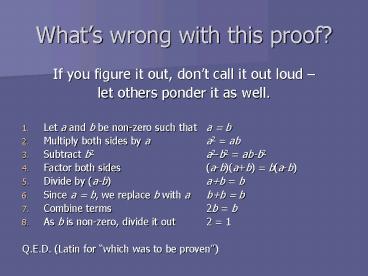What - PowerPoint PPT Presentation
Title:
What
Description:
So we'll be seeing puzzles and brain teasers this semester. And you get to contribute! ... Brain teasers. This is one reason why there are labs recitation ... – PowerPoint PPT presentation
Number of Views:66
Avg rating:3.0/5.0
Title: What
1
Whats wrong with this proof?
- If you figure it out, dont call it out loud
- let others ponder it as well.
- Let a and b be non-zero such that a b
- Multiply both sides by a a2 ab
- Subtract b2 a2-b2 ab-b2
- Factor both sides (a-b)(ab) b(a-b)
- Divide by (a-b) ab b
- Since a b, we replace b with a bb b
- Combine terms 2b b
- As b is non-zero, divide it out 2 1
- Q.E.D. (Latin for which was to be proven)
2
CS 202 Discrete Math
- Spring 2007
- Aaron Bloomfield
3
So. What is it?
- Discrete mathematics is the study of
mathematical structures that are fundamentally
discrete, in the sense of not supporting or
requiring the notion of continuity (wikipedia) - In other words, dealing with integer things
(sets, logic, proofs, etc.) and not continuous
things (calculus, functions, etc.)
4
Why discrete math?
- It forms the basis for computer science
- Sequences
- Digital logic (how computers compute)
- Algorithms
- Assuring computer correctness
- Probability and gambling (really!)
- Etc.
- Like how regular math forms the basis for
science
5
Sequences in Nature
13 8 5 3 2 1
6
Proofs
- How do you know something is correct?
- How do you know when something is not correct?
- Such as showing that 21?
- How do you think logically?
- How do you think to solve problems?
7
Whats wrong with this proof?
- If you figure it out, dont call it out loud
- let others ponder it as well.
- Let a and b be non-zero such that a b
- Multiply both sides by a a2 ab
- Subtract b2 a2-b2 ab-b2
- Factor both sides (a-b)(ab) b(a-b)
- Divide by (a-b) ab b
- Since a b, we replace b with a bb b
- Combine terms 2b b
- As b is non-zero, divide it out 2 1
- Q.E.D. (Latin for which was to be demonstrated)
8
Why am I here?
9
Course objectives
- Logic Introduce a formal system (propositional
and predicate logic) which mathematical reasoning
is based on - Proofs Develop an understanding of how to read
and construct valid mathematical arguments
(proofs) and understand mathematical statements
(theorems), including inductive proofs. Also,
introduce and work with various problem solving
strategies and techniques - Counting Introduce the basics of integer theory,
combinatorics, and counting principles, including
a brief introduction to discrete probability - Structures Introduce and work with important
discrete data structures such as sets, relations,
sequences, and discrete functions - Applications Gain an understanding of some
application areas of the material covered in the
course
10
Who am I?
- Aaron Bloomfield
- Office Olsson 228D
- Office hours M/W 400-530
11
Who are they?
- We will have a number of teaching assistants
- Who will be holding office hours
- This will be posted on the website in a few days
- Office hours start next week
12
Going over the syllabus
13
Textbook (Required)
- Susanna Epp
- Discrete Mathematics with Applications, 3rd
edition - ISBN 0534359450
- Sorry about the price!
14
Other Issues
- Privacy
- Keeping the class interesting
- Most of you know that I like humor
- But most of you have seen my humor
- So well be seeing puzzles and brain teasers this
semester - And you get to contribute!
15
Where did the money go?
- Three people check into a hotel. They pay 30 to
the manager and go to their room. The manager
suddenly remembers that the room rate is 25 and
gives 5 to the bellboy to return to the people.
On the way to the room the bellboy reasons that
5 would be difficult to share among three people
so he pockets 2 and gives 1 to each person. Now
each person paid 10 and got back 1. So they
paid 9 each, totaling 27. The bellboy has 2,
totaling 29. Where is the missing 1?
16
Feedback
- Its a very good thing!
- Feel free to leave us feedback
- Can be done anonymously, if you wish
- Via the Toolkit or the CS dept website
- Its hard for the instructors to know what the
students think of the course
17
The Study
- How does one make a discrete math class more
interesting? - By adding
- Nifty problems
- Application examples
- Physical demonstrations
- Interactive demonstrations
- Brain teasers
- This is one reason why there are labs recitation
sections.
18
Scheduling Issues
- This room has 94 seats
- One of the lab sections (11 a.m.) has 42 seats
- I will course action people in starting next
Monday - I am planning on taking a survey of who wants to
get into which section - For now, come to the 100 recitation if you can
19
The survey
- This will help me with the recitation scheduling,
background material coverage, etc.































